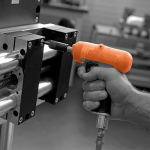Quick guide to get the most out of your pulse tools

Learn how to get the best environment to operate your high precision tools in.
A pneumatic Pulse Tool is a common choice for quality critical applications. In order for the tool to be able to deliver maximum performance, it is key that it operates in a stable environment.
Ensure a stable air pressure at the tool’s level:
It is key for your tool’s performance and accuracy to make sure that the air pressure going into the tool is stable.
Unstable air pressure dramatically changes pulse tool’s performance and different pulse tool technologies have varying operating ranges. As an example – the Fuji FLT-series operates between 5-6.3 bars while the Fuji FPT series operates between 5-6.3 bars.
These pressures are measured at air regulator while free-running, so called “dynamic pressure”, with 6-meter hose.
Learn more about the importance of the compressed air here.
Use the correct equipment between the pulse tool and the regulator:
Pulse tools do not have large air flow requirements, but it is key to ensure that the flow they need is available for accuracy concerns. The equipment between the tool and the regulator can impair the performance of the tool. We recommend using full flow couplings and avoiding spiral hoses where possible.
Our advice: Try to have the installation featuring straight hoses with suitable diameter and keep the number of connections to a minimum. If spiral hoses or hose reels must be used, it is prudent to oversize them in order to minimize the effect. Of course, any air leak in the system can have a negative effect on performance. It is always a good thing, after installation, to walk the line listening for leaks.
Don’t underestimate the impact of the sockets:
Between the tool and the joint there will be a socket. This socket is also a key component of the performance the system can deliver. The type of socket (Hex, Torx, Inside hex etc.) and its length is decided by the bolt or screw that is to be tightened. From a performance point of view, minimal play between the socket and the tool anvil (the square drive part of the tool) is best.
Less play means a better and more stable energy transfer which translates into a higher and more stable torque in the joint. For pulse tools, the so called “Sleeve Drive” sockets are recommended. Sleeve Drive sockets are extended towards the tool with a part that fits snuggly on the outgoing shaft behind the square drive. This minimizes play and ensures that the socket is more centered. The difference is significantly better energy transfer, less torque scatter and better tool lifespan. Especially for longer sockets, (more than 70mm) using sleeve drive is important. With a long socket, it is easy for the tool to not be in-line with the bolt when tightening, which affects both torque scatter and puts wear on the bearings in the front of the tool. The Sleeve Drive helps the operator keep the tool centered.
Extension sockets or universal joint sockets should be avoided with pulse tools. Having multiple interfaces between the tool and the joint multiplies energy losses and variations between tightening. Long sockets and extensions can also have a “wind-up” effect working basically as a spring which can either add or subtract significantly from the energy delivered to the joint.
Follow our 7 key advice to ensure you have the best set-up to operate pulse tools:
Giving a pulse tool the best environment to perform in is logical based on the cost of the investment and the importance of the joints it is used on. Air quality and sockets are two key outside factors impacting performance. Our top seven advice are:
- Use a regulator, filter and lubricator for each air tool. Measure the pressure at the tool when it is running.
- Set the regulator to deliver a stable pressure to the tool. Stable pressure is more important than high pressure! Try to keep the regulator set at 0.5-1 bar lower than the available pressure.
- Avoid hose reels and spiral hoses or over-dimension them to reduce pressure drop to the tool.
- Use sleeve drive sockets together with pulse tools, it will give more stable results and reduce tool wear. It is especially important when a longer socket is needed.
- Never use universal sockets or multiple extensions with a shut-off pulse tool. The torque scatter will be so large that the shut-off function has no value. Use a non-shut-off tool or an impact wrench.
- When starting a tool under cold circumstances (<10deg Celsius), run the pulse unit at least 30 seconds to heat up the oil inside. Otherwise the first tightening may not deliver the set torque.
Since these environmental factors are key to the performance and delivered torque – always set up a pulse tool at the application, using the same hoses, sockets and air pressure that will be used in normal running conditions.